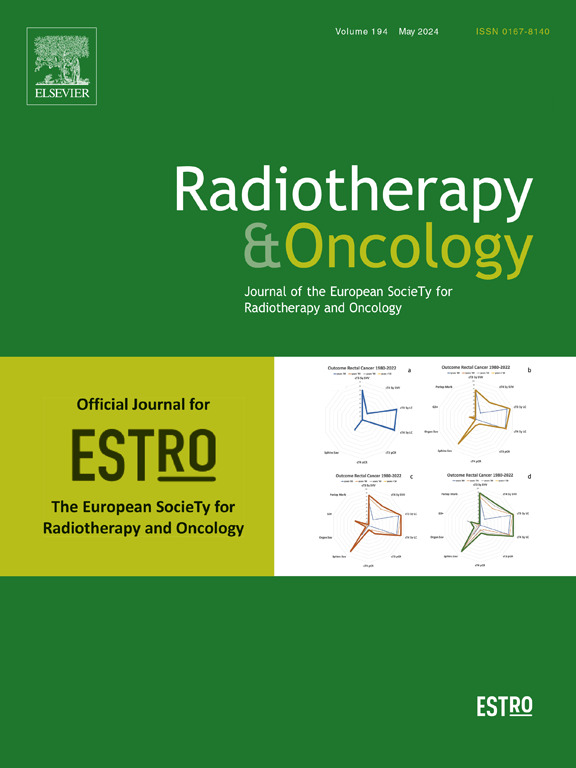有限期小细胞肺癌的胸部放疗方案:系统回顾和网络荟萃分析
IF 4.9
1区 医学
Q1 ONCOLOGY
引用次数: 0
摘要
目前,公认的有限期小细胞肺癌(LS-SCLC)的标准治疗是同步放化疗;然而,胸部放射治疗方案仍然存在争议。因此,本荟萃分析旨在比较不同胸部放疗方案的疗效和安全性。方法从PubMed、Cochrane图书馆、Web of Science和EMBASE中检索相关随机对照试验(rct),评估抗肿瘤效果(总生存期、OS;无进展生存期;总有效率(ORR)和毒性(不良反应,ae)。结果在2225篇筛选文章中,纳入8项随机对照试验(rct),共涉及2363例患者。控制臂定义为45 Gy/30f BID。实验臂分为三组:高剂量超分离(hHyper-RT: 54 Gy/30f BID, 60 Gy/40f BID)、低剂量分离(hHyper-RT: 42 Gy/15f QD, 65 Gy/26f QD)和常规分离(convr: 45 Gy/25f QD, 66 Gy/33f QD, 70 Gy/35f QD)。与45 Gy/30f BID相比,hHyper-RT (54 Gy/30f BID和60 Gy/40f BID)改善了OS (HR = 0.55, 95% CI: 0.37—0.82;HR = 0.69, 95% CI: 0.48—0.99),hHyper-RT (54 Gy/30f BID)和Hypo-RT (65 Gy/26f QD)改善PFS (HR = 0.70, 95% CI: 0.49—0.99;HR = 0.78, 95% CI: 0.62—0.98),而采用convr - rt的OS和PFS与45 Gy/30f BID相当。45 Gy/30f、hHyper-RT和hypor - rt组AE的发生具有可同性,而45 Gy/25f QD的convr - rt组可降低食管炎和3-5级食管炎的发生风险(RR = 0.70, 95% CI: 0.58-0.85;Rr = 0.50, 95% ci: 0.35-0.72)。两组间ORR、肺炎或3-5级肺炎的发生率无显著差异。结论与45 Gy/30f BID相比,hHyper-RT (54 Gy/30f BID和60 Gy/40f BID)改善了LS-SCLC患者的OS,而hHyper-RT (54 Gy/30f BID)和Hypo-RT (65 Gy/26f QD)延长了PFS,毒性可接受。本文章由计算机程序翻译,如有差异,请以英文原文为准。
Thoracic radiotherapy schedules in limited-stage small cell lung cancer: A systematic review and network meta-analysis
Background
Currently, the accepted standard management of limited-stage small cell lung cancer (LS-SCLC) is concurrent chemoradiotherapy; however, the thoracic radiotherapy regimen remains controversial. Therefore, this meta-analysis aims to compare efficacy and safety of different thoracic radiotherapy regimens.
Methods
Relevant randomized controlled trials (RCTs) were sourced in PubMed, Cochrane Library, Web of Science, and EMBASE to assess antitumor effects (overall survival, OS; progression-free survival, PFS; overall response rate, ORR) and toxicity (adverse effects, AEs).
Results
Of the 2225 screened articles, 8 RCTs (involving 2363 patients) were included. The control arm was defined as 45 Gy/30f BID. The experimental arms were categorized into three groups: high-dose hyper-fractionation (hHyper-RT: 54 Gy/30f BID, 60 Gy/40f BID), hypo-fractionation (Hypo-RT: 42 Gy/15f QD, 65 Gy/26f QD), and conventional fractionation (Conv-RT: 45 Gy/25f QD, 66 Gy/33f QD, 70 Gy/35f QD). Compared with 45 Gy/30f BID, hHyper-RT (54 Gy/30f BID and 60 Gy/40f BID) showed improved OS (HR = 0.55, 95 % CI: 0.37–––0.82; HR = 0.69, 95 % CI: 0.48–––0.99), hHyper-RT (54 Gy/30f BID) and Hypo-RT (65 Gy/26f QD) improved PFS (HR = 0.70, 95 % CI: 0.49–––0.99; HR = 0.78, 95 % CI: 0.62–––0.98), whereas OS and PFS with Conv-RT was comparable to that of 45 Gy/30f BID. AE development was comparable among 45 Gy/30f, hHyper-RT, and Hypo-RT, whereas Conv-RT (45 Gy/25f QD) reduces the risk of esophagitis and grade 3–5 esophagitis (RR = 0.70, 95 % CI: 0.58–0.85; RR = 0.50, 95 % CI: 0.35–0.72). No significant difference was found for ORR, pneumonitis or grade 3–5 pneumonitis between the study arms.
Conclusions
Compared with 45 Gy/30f BID, hHyper-RT (54 Gy/30f BID and 60 Gy/40f BID) improved OS, while hHyper-RT (54 Gy/30f BID) and Hypo-RT (65 Gy/26f QD) prolonged PFS in LS-SCLC patients, with accepted toxicity.
求助全文
通过发布文献求助,成功后即可免费获取论文全文。
去求助
来源期刊

Radiotherapy and Oncology
医学-核医学
CiteScore
10.30
自引率
10.50%
发文量
2445
审稿时长
45 days
期刊介绍:
Radiotherapy and Oncology publishes papers describing original research as well as review articles. It covers areas of interest relating to radiation oncology. This includes: clinical radiotherapy, combined modality treatment, translational studies, epidemiological outcomes, imaging, dosimetry, and radiation therapy planning, experimental work in radiobiology, chemobiology, hyperthermia and tumour biology, as well as data science in radiation oncology and physics aspects relevant to oncology.Papers on more general aspects of interest to the radiation oncologist including chemotherapy, surgery and immunology are also published.
 求助内容:
求助内容: 应助结果提醒方式:
应助结果提醒方式:


